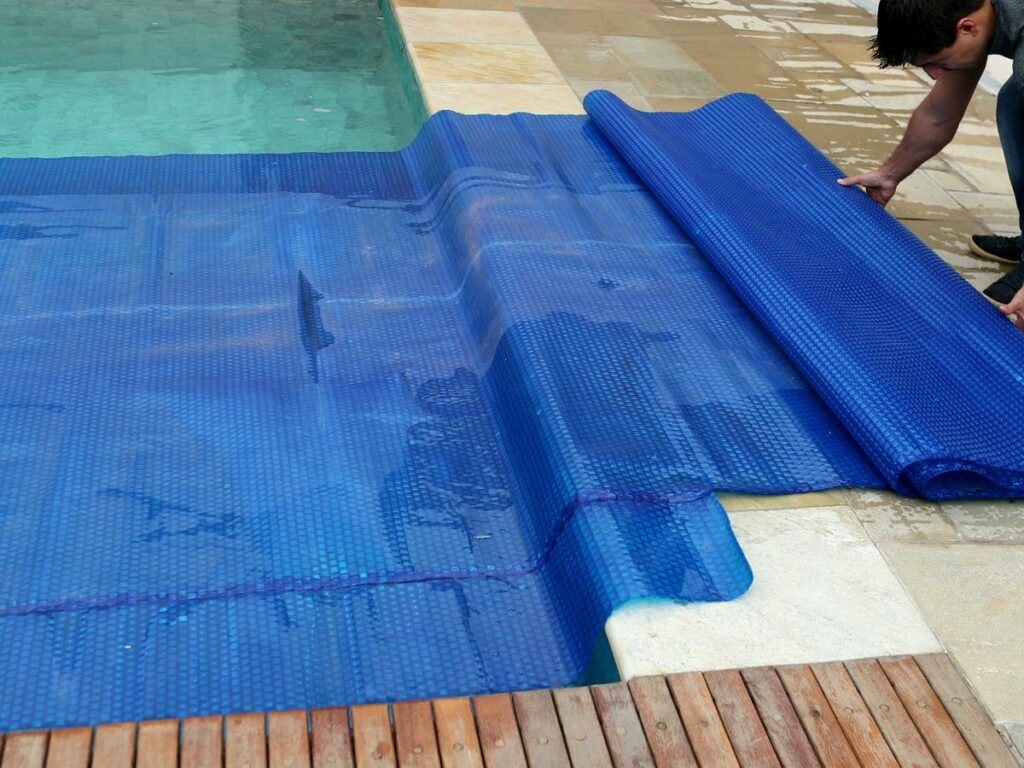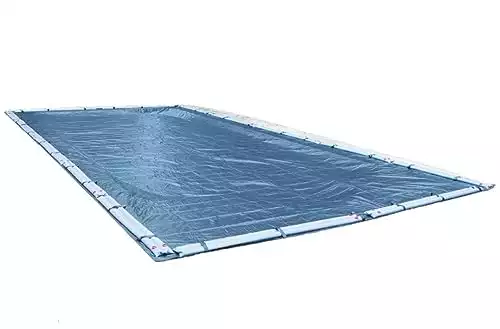How to Cover Pool for Winter: A Comprehensive Guide
As a participant in the Amazon Services LLC Associates Program and other affiliate programs, Easy Homemade Life may collect a share of sales or other compensation from the links on this page. This comes at no additional cost to you, and all the prices and availability are accurate at the time of publishing.
The winter season is coming, and knowing how to cover a pool for winter is quickly becoming more important. Covering it up over the cold winter months is an effective proactive measure that pays off in the long run by saving you time, effort, and resources.

Prepping the pool and outside plants like succulents for winter should be on your checklist before temperatures drop. I’ll help you figure out how to properly cover an inground pool this winter, so you can apply efficient and cost-effective pool maintenance and won’t have to spend so much time and energy opening it up next year.
Why Winter Pool Covering Matters
Some pool owners think covering their pool is just another chore to do, like carpet care, and try to push it off for as long as possible. Similar to cleaning a dehumidifier and caring for cast iron, the job doesn’t sound fun but there are simple steps that are worth learning because they save you a lot of time and effort long-term.
All sorts of debris can pile up and algae will surely start growing if you forget to tend to your pool before the temperatures take a nosedive. Not to mention, essential pool components like the pump and filter will be exposed to harsh weather. This could eventually lead to expensive maintenance and repair costs if not properly addressed.
The holiday season is just around the corner, and I know there are way more fun things to look forward to like holiday coffee, Christmas blend coffee, boiled custard, unique gifts, and hosting parties left and right. Force yourself to take the time now to dial in your pool care and you’ll thank me later.
Ground pool covers are part of pool winterization and well worth the effort to install and maintain. It’s a little effort upfront so you can keep your pool clean and ready for the next time you decide to open it back up for swimming season.

Assessing Your Pool and Gathering Supplies
The best way to start is by preparing the following materials if you’re planning to cover up your pool for the winter season. Keep your pool safe and protected from the harsh winter weather with these things:
|
Primary Rating:
3.5
|
Primary Rating:
4.5
|
Primary Rating:
4.7
|
|
|
$164.92
|
|
Thoroughly inspect your pool before covering it for the winter. Also, don’t forget to check for any cracks or leaks in the pool’s structure and address them immediately.
Additionally, it’s important to ensure that the pool’s water chemistry is balanced and equipment is in good working condition. These proactive measures can help prevent any potential damage to your pool during the winter.
Before winter sets in, make sure to clean your pool by removing debris and floating items, brushing and vacuuming it, and using a winterizing chemical kit to prevent algae growth.

Selecting the Right Winter Pool Cover
Choosing the right pool cover when closing your pool for winter makes all the difference. What’s the point of doing this if the cover won’t stand up to the specific weather conditions of your area?
There are different covers made from several materials, so you can review the best options that match your needs. If you live in a colder area, you’ll need a solid pool cover. This will keep out the harsh winter weather.
On the other hand, milder regions need a lighter cover. I live in a more temperate area, where it would be acceptable to cover a pool with a mesh cover or leaf net. The mesh material is lightweight and allows some sun and rain water to pass through while still blocking debris.
Take some time to figure out which type you need beforehand. Investing in a pool cover that’s right for your local climate can help you save on energy costs by retaining heat. Plus, they’ll keep pesky debris out of your pool, making it easier to maintain and keep clean.
Preparing Your Pool for Covering
Unfortunately, covering your pool this winter isn’t as simple as placing the cover across the water. It would help if you also prepped your pool first. Properly preparing your pool for winter covering involves a meticulous process.
Here are the necessary steps if you have an inground pool:
- Start by using a net skimmer to remove debris on the water surface.
- Use a vacuum to clean the pool floor and a cleaning sponge for the water line.
- Test the pH level of your pool. It should be between 7.0 and 7.2 pH.
- Turn off the filter system and set your filter to “backwash.” Then, set the valves to the main drains and turn on your filter.
- Shut the filter system and set it to “waste.” Let it run to drain your pool below the skimmer.
- Then, blow out the lines with an air blower or an air compressor.
- Install winter plugs in your pool’s return nozzle. Alternatively, you can place an ice protector in the skimmer.
- Add winter chemicals to your pool and finally, you’re ready to cover your pool.

Installing the Pool Cover
Once you’re done preparing your pool, it’s now time to install the pool cover. Here’s how to cover inground pool for winter:
- Review that the cover is clean and free from any debris.
- Lay the cover over the pool water, allowing it to overlap the edges.
- Center the cover so that it covers all sides equally.
- Smooth out any wrinkles on the surface of the cover. If your cover wrinkles or sags during installation, reposition it and smooth it out a second time.
Make sure that your pool cover is secure enough so it won’t budge once the weather gets harsh. Ratchet straps are my top pick because they are good at securing the cover in place, clip on easily, and adjust without a lot of muscle power. You can also use anchors or water bags on the edge of the cover, depending on the type of cover you have.
|
Primary Rating:
4.0
|
Primary Rating:
4.6
|
Primary Rating:
3.5
|
|
$29.90
|
|
|
Maintaining Your Covered Pool
I highly recommend running a routine monthly check even after you get the initial winterized pool set up in place. Regular maintenance, just a few times through the winter is helpful to avoid unexpected problems down the line and protect the life of your pool
More frequent checks may be needed if your area experiences severe snowfall or ice. Play it by ear and consider your pool system after heavy storms. You’ll want to remove debris accumulation as soon as it happens. Watch out for falling tree branches during and after strong winds.
Under normal circumstances, check that the water level remains within the recommended range. If it isn’t, there could be a leak. Scan for algae while you’re taking a peek at the water too.
Next, review the pool cover for signs of wear or damage. Holes and loose fittings should be fixed and replaced. Likewise, look over the equipment for signs of damage.
Moreover, avoid using sharp tools to break accumulated ice over the pool cover. Instead, use a soft broom or pool brush to remove snow or ice gently. Use a cover pump when you see water pooling up and weighing down the top of the cover. Acting quickly prevents excess weight strain on the cover.
Uncovering the Pool in Spring
It’s time to uncover the pool as soon as the weather warms up. But before you dive in, make sure the area around your pool is free of debris. The last thing you want is a dirty pool now when you take the cover off, after you’ve just put the effort into keeping it clean through winter.
Take it slow and steady when removing your pool’s cover. Have a helper if possible and do the following steps:
- Begin at one end.
- Gently pull the cover towards you, folding it as you go.
- Clean and store the cover properly to extend its lifespan.
Take your time to inspect everything once you have removed the cover from your pool. Look for cracks, leaks, or any damage, and test your equipment to make sure it’s working properly. If you notice any issues, make sure to address them right away with a pool specialist so you can start the season off with a clean and safe pool.
In Conclusion
As winter approaches, covering your pool may seem like a bit of work, but the alternative of leaving an uncovered pool during the cold weather is not worth the risk. Following this simple step-by-step outline ensures the safety of your loved ones, protects against harsh winters, and extends the lifespan of the cover.
Taking good care of your pool and swimming pool cover during the colder months guarantees that it will last for many years to come. In short, the benefits far outweigh the effort, and good things come to those who safeguard their pool season after season.
Step By Step to Cover a Pool for Winter
Equipment
- 1 Net skimmer
- 1 Cleaning sponge
- 1 Cover pump
Instructions
- Prep the pool according to the post directions or your preferred method.
- Review that the cover is clean and free from any debris.
- Lay the cover over the pool water, ensuring that it overlaps the edges.
- Center the cover so that it covers all sides equally.
- Smooth out any wrinkles on the surface of the cover. If your cover wrinkles or sags during installation, reposition it and smooth it out.
- Weight the cover down appropriately so it stays in place. Use rachet straps to clip on and tighten, attach the cover to anchors, or use water bags on the edge of the cover.
















This was so helpful to me as a first time home/pool owner. It may be January already but we’re supposed to get our first big freeze of the season this coming week. Time to get to work!
Thanks, Jill. First timers often forget this information. Glad you found it helpful!